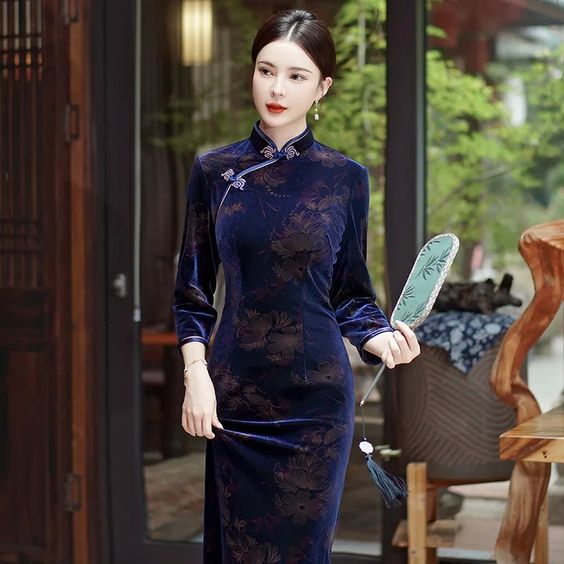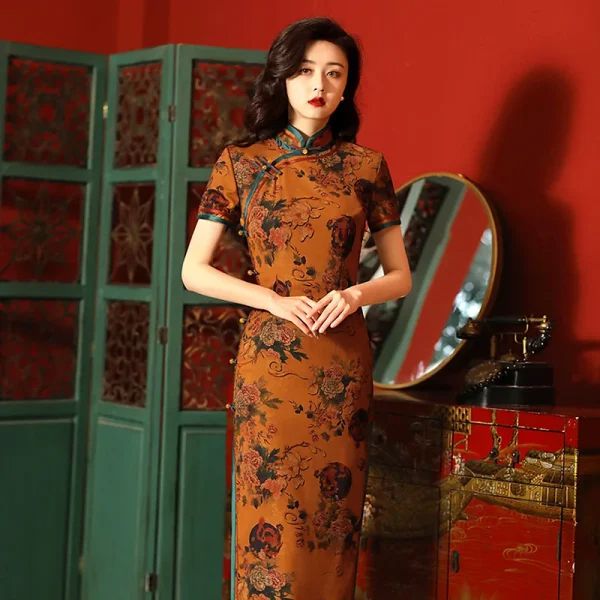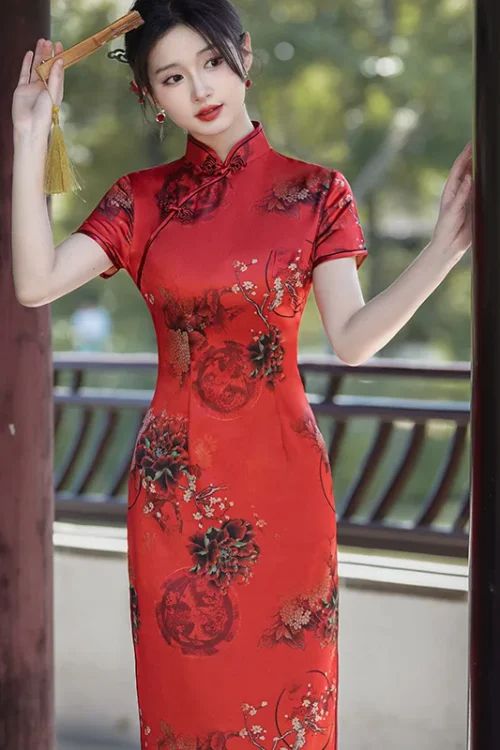The Evolution of Floral Patterns on Qipao
The qipao, an iconic Chinese dress, has captivated fashion enthusiasts for centuries with its intricate floral embellishments. The evolution of these patterns is a testament to the rich cultural heritage and artistic sensibilities that have shaped the qipao’s enduring appeal.

Early Iterations
In its early iterations, the qipao featured simple floral motifs, often embroidered in silk or satin. These designs drew inspiration from traditional Chinese painting, with delicate brushstrokes capturing the essence of nature. As the qipao gained popularity, the floral patterns became more elaborate, incorporating a wider range of colors and textures.
Transformation During the Republican Era
During the Republican era, the qipao underwent a significant transformation. Western influences began to permeate Chinese fashion, and the floral patterns on qipaos reflected this fusion of styles. Art Deco motifs, with their geometric lines and bold colors, were incorporated into the designs, creating a striking and modern aesthetic.
Golden Age of Qipao Fashion
The 1930s and 1940s witnessed a golden age for qipao fashion. Shanghai, the epicenter of Chinese glamour, became a hub for renowned designers who pushed the boundaries of floral embellishments. Intricate beading, sequins, and lace were used to create opulent and eye-catching patterns.
Resurgence in Popularity
After the founding of the People’s Republic of China, the qipao’s popularity waned somewhat. However, in recent decades, there has been a resurgence of interest in this traditional vêtement. Contemporary designers have reinterpreted the floral patterns, infusing them with fresh and innovative ideas.
Modern Floral Embellishments
Today, the qipao’s floral embellishments continue to evolve, reflecting the changing tastes and sensibilities of modern society. While traditional motifs remain popular, designers are also experimenting with abstract patterns, unconventional color combinations, and new techniques.
Conclusion
The evolution of flower patterns on qipao is a testament to the garment’s enduring appeal and its ability to adapt to changing times. From its humble beginnings to its current status as a symbol of Chinese fashion, the qipao’s floral embellishments have played a vital role in shaping its identity and capturing the imagination of generations.
The Influence of Western Fashion on Qipao’s Flower Patterns
The qipao, an iconic Chinese dress, has undergone a remarkable evolution in its flower patterns, influenced by the interplay of traditional Chinese aesthetics and Western fashion trends.

Early Inspirations
Initially, qipao flower patterns were predominantly inspired by nature, featuring delicate depictions of flowers, birds, and landscapes. These patterns were often embroidered in intricate detail, showcasing the skill and artistry of Chinese artisans. However, as Western influences began to permeate Chinese society in the early 20th century, qipao flower patterns underwent a gradual transformation.
Western Influence
Western fashion introduced bold, geometric patterns and vibrant colors, which were incorporated into qipao designs. The use of lace, sequins, and beads added a touch of opulence and glamour to the traditional qipao. Moreover, Western-inspired floral motifs, such as roses and lilies, became popular, adding a touch of romanticism to the dress.
Unique Blend of Cultures
The fusion of Eastern and Western aesthetics resulted in a unique and eclectic style of qipao flower patterns. Traditional Chinese motifs were often combined with Western elements, creating a harmonious blend of cultures. For example, a qipao might feature a traditional peony pattern embroidered in vibrant Western-inspired colors.
The Golden Age of Qipao
The influence of Western fashion on qipao flower patterns was particularly evident during the 1930s and 1940s, a period known as the “Golden Age of Qipao.” During this time, the qipao became a symbol of modernity and sophistication, and its flower patterns reflected the changing tastes of Chinese women.
Post-War Evolution
In the post-World War II era, qipao flower patterns continued to evolve, incorporating elements from various fashion trends. The 1950s saw the rise of abstract and minimalist patterns, while the 1960s and 1970s brought a resurgence of traditional Chinese motifs.
Designs contemporains
Today, qipao flower patterns continue to draw inspiration from both Eastern and Western sources. Contemporary designers experiment with a wide range of patterns, from traditional Chinese embroidery to modern abstract designs. The qipao has become a versatile garment that can be adapted to suit different occasions and personal styles.
Conclusion
The evolution of flower patterns on qipao reflects the dynamic interplay between Chinese tradition and Western influences. As the qipao continues to evolve, its flower patterns will undoubtedly continue to reflect the changing tastes and aspirations of Chinese women.
Moderne Interpretations of Floral Patterns on Qipao
The qipao, an iconic Chinese dress, has undergone a remarkable evolution in its floral patterns, reflecting the changing aesthetics and cultural influences over time.

Traditional Motifs
Traditionally, qipaos featured intricate embroidery or printed designs inspired by nature, with motifs such as peonies, chrysanthemums, and plum blossoms symbolizing auspiciousness and beauty.
Republican Era Changes
During the Republican era (1912-1949), the qipao experienced a surge in popularity and modernization. Western influences led to the incorporation of Art Deco and geometric patterns, creating a more streamlined and sophisticated look. Floral motifs became more stylized and abstract, with bold colors and simplified forms.
Post-War Innovations
In the post-war period, the qipao continued to evolve, with designers experimenting with new materials and techniques. Synthetic fabrics and machine embroidery allowed for mass production, making the qipao more accessible to a wider audience. Floral patterns became more vibrant and playful, reflecting the optimism and economic growth of the time.
Revival of Traditional Culture
The 1980s and 1990s witnessed a revival of traditional Chinese culture, which influenced the design of qipaos. Designers drew inspiration from ancient textiles and paintings, incorporating classic floral motifs with a contemporary twist. Embroidery techniques became more elaborate, with intricate beading and sequins adding a touch of opulence.
Contemporary Eclecticism
In recent years, modern interpretations of floral patterns on qipaos have emerged, reflecting the globalized fashion landscape. Designers have fused traditional Chinese elements with Western influences, creating unique and eclectic designs. Floral motifs are often combined with abstract prints, geometric shapes, and bold colors, resulting in a vibrant and contemporary aesthetic.
Conclusion
The evolution of flower patterns on qipao is a testament to the enduring appeal of this iconic garment. From traditional embroidery to modern interpretations, floral motifs have played a central role in shaping the qipao’s identity. As designers continue to push the boundaries of creativity, the qipao remains a symbol of Chinese culture and a canvas for artistic expression.
